Continuous cover forestry: Management practice
Ian Barton, New Zealand Tree Grower May 2006.
This is the second and final part of the article on continuous cover forestry.
The first part was published in the November 2005 issue of the Tree Grower.
Establishing the continuous cover forest
New forest on bare ground
This requires a similar approach to the planting of a single species, even-aged forest. But more attention must be paid to choosing species best suited to the site and planting appropriately. For example species like totara are better suited to drier sites while rimu and kahikatea will succeed better on moist sites. Kauri will establish on either but grows much faster where moisture is readily available.
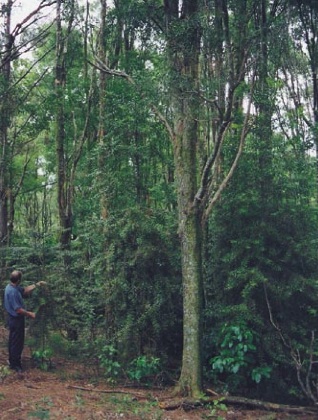
All grow better on soils of good quality and poor soils need amelioration by cultivation and fertilising. Because management involves following ecological principles, the siting of seedlings should result in a mixture of species – often planted in small groups. If planting in the open, nurse plants will probably be required. These can be either indigenous or exotic and preference should be given to choosing the most effective nurse.
Conversion of a mature, even-aged stand in full production
The best approach is to divide the block into more or less equal areas or coupes which will range in size from a few square metres to about a fifth of a hectare. The actual size depends upon the site requirements of the species being introduced. Coupes will be felled over a predetermined time and planted or regenerated with the appropriate mixture of species for continuous cover forestry. If the original species is to be completely replaced with others then it must be prevented from regenerating.
An example concerned the conversion of a Douglas fir plantation, 10 hectares in area and 35 years old. The conversion process envisaged regenerating small groups every 5 years for 35 years. If the average group size were set at 1,500 square metres then eight of these groups would be felled every 5 years.
Conversion of young even-aged stands
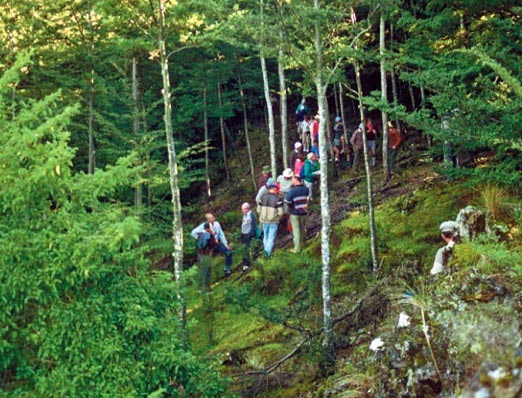
This is essentially the same as the previous option but initially the trees will not be large enough for economic harvest. Examples include situations where several species are regenerating through an indigenous or exotic scrub canopy or where several species have been deliberately planted under such a canopy.
Single tree selection, group selection or irregular shelter wood systems can be used for management, depending on the relative shade tolerance of the species concerned. The aim is to develop greater structural diversity within the stand by encouraging the growth of better quality trees chosen because they have greater root stability, good form and vigour, and are appropriately spaced. At the point where these trees emerge through the scrub canopy there should be up to 300 stems per hectare. Higher stocking will reduce the quantity and quality of following regeneration and long term productivity.
As the stand ages, natural regeneration, begins to colonise the under storey. From the beginning progressive thinning the canopy of nurse or non crop species will open up gaps and encourage rapid growth of regenerating seedlings. Because of differing light levels within the stand, these seedlings will have variable height growth as more favoured trees grow towards the canopy establishing the two to four tiered canopy structure. Up to 50 years may be required to reach this point and from now management is aimed at developing the ‘reverse-J’ structure traditionally identified with classical selection systems.
Conversion of a mature but degraded forest
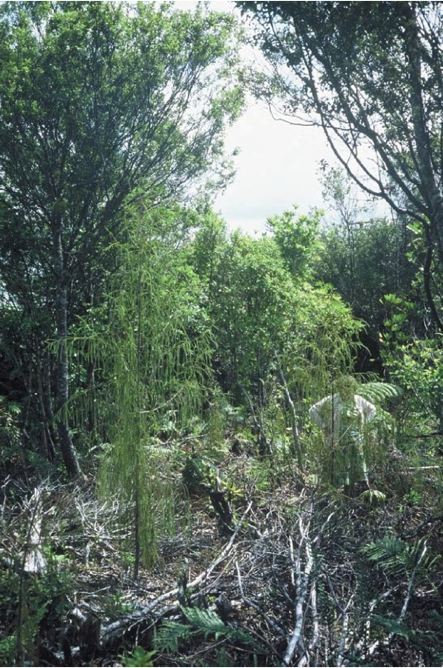
In New Zealand such sites will mostly be indigenous cutover forest but could be a failed exotic stand. The process here takes notice of the condition of the existing forest and the inventory will be more complex than that for converting an even-aged plantation. This is because it may have pockets of quite high quality forest or areas with no desirable species at all.
The stand is mapped identifying those areas which, on the basis of current quality, will improve if carefully tended. These are treated appropriately carrying out whatever thinning, pruning or releasing may be required.
Remaining areas are scheduled for replacement over a predetermined time period. For example if the total area of forest to be upgraded is 10 hectares and it is desired to do the work on an annual basis over a 15 year period, then 0.67 hectares should be treated each year.
Sizes of individual coupes should be similar and not greater than 2000 square metres. Poor trees are felled with any useable wood removed, followed by re-planting or regeneration of these areas. Small groups of good existing regeneration are retained and thinned if required. The occasional pole or small tree with potential is also left.
An example of the type of forest which might be managed in this way is old kauri cutover which has scattered regeneration, from seedlings to small pole size, usually on ridges. Similar sized tanekaha will be found throughout and there will be scattered rimu and totara. Gullies generally contain only scrub hardwoods and tree ferns and can be converted to timber species by careful management.
Conversion of young, even-aged stands of scrub species
The site will usually be dominated by one species such as kanuka or gorse. There may be some early regeneration of timber species.
The choice of silvicultural system will depend on the appearance and pattern of any natural regeneration and what additional planting is required. If regeneration is present then the distribution of this is used as a guide for supplementary planting. If there is no regeneration, planting should be carried out using ecological knowledge of the species concerned. Once the site is fully stocked with seedlings, releasing must be done as frequently as required.
Silviculture
Successful continuous cover forestry requires a higher standard of silviculture than that practiced with even-aged, clear fell management systems. Inventory is essential, for in each part of a continuous cover forest there must be a full range of age classes with, continual additions to the growing stock by natural regeneration or planting. Inventory builds up knowledge of the species and size classes present in the forest and is vital to the process.
Silvicultural activities, based upon the ecology of the forest, are not confined to specific parts of the forest but take place in many stands at any one time. Harvesting by single tree or group selection depends on the shade tolerance and seedling regeneration characteristics of the species. Harvesting is not confined to the removal of large trees. Some of these may be left to grow to their fullest potential, occasional poor trees are left for habitat purposes, and smaller trees may be removed to give more vigorous neighbours greater space. The main selection criteria are to remove trees with reduced increment, impaired health and vigour, those which are malformed or damaged and thinning to reduce density. The objective is to allow the best of the dominant trees to put on as much volume as possible while allowing subdominants to increase their growth rate when their over story is removed.
Continuous cover forests are managed for production so there will be some diversion from natural processes. For example they may be single species forests, mixtures of native and exotic tree species, or infertile species where planting of replacement stock will be required. Ecological requirements of different species, growing in the same stand, will need to be compatible and a good deal of trial and error will be needed to devise a suitable silvicultural processes.
Following harvesting, growth at all levels in the continuous cover forest must be encouraged. New tree establishment is obtained by encouraging seed germination and coppice regrowth or, as a last resort, planting. Existing seedlings and saplings need to be released from competition and excessive numbers thinned. Repeat releasings are likely during the first few years to free newly planted or germinated seedlings from competition. Encouraging regeneration requires control of seed supply, light levels, competition and predation of both seed and small seedlings.
Yield control and inventory
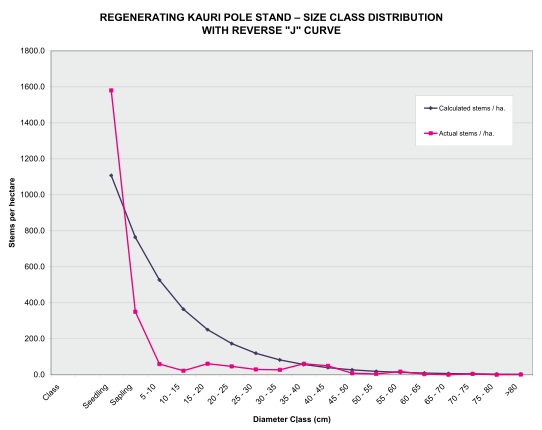
Yield regulation in the continuous cover forest is done by dividing the forest into stands of similar species and size classes and making inventories of the growing stock every six to ten years. This enables determination of the relationship between increment and growing stock, the determination of yield for the next period and planning felling in order to maintain a normal distribution of size classes.
The basic rules are –
- Maintain various tree age and size classes in the correct proportion, the number of plants in each size class should be about double that of the class above it.
- With a mixture of tree species, try and maintain a consistent percentage mix of species in each age class.
- Free young seedlings and saplings from suppression
- Remove defective stems whenever they hamper better ones, unless they are important for habitat.
The focus is on size rather than age and target diameters should be adopted for the forest. In Europe these can be as high as 60 to 70 cm but have not been determined for New Zealand. Other parameters are residual basal area, stem size distribution and shape of the reverse J curve. Here the objective is to bring the seedling and tree size distribution curve of stand close to the theoretical one over time.
Rotation
Crop rotation, as applied to plantation forestry, has no place in continuous cover forestry where the important criterion is the cycle of individual trees from establishment to felling. A fully productive continuous cover forest could be composed of several species, each with a different growth cycle. If the forest is well managed, the individual cycle lengths will be as short as needed to produce maximum volumes of high quality timber.
Management plans
Good management is controlling yield by keeping the annual harvest volume at or below the annual increment. It is based on knowledge of the dynamics of the forest and sound ecological principles.
A good operating plan is essential. For example, where ground hauling methods are to be used, a well planned network of skidder tracks spaced at about 40 metre intervals is needed. All main ridge and valley systems will need to be accurately mapped and contour plans drawn.
Initially the forest should be mapped by forest type. This is normally dictated by the dominant species and is required whether the forest natural or planted. This is the first step in making an inventory of the forest and as more data is obtained the more refined the forest plan becomes. The completed management plan should have individual stands mapped by GPS.
Monitoring and reserve areas
Monitoring is essential. If the inventory is not in place and accurate control of the yield is not maintained, it is very easy for the forest to become degraded due to –
- Uncontrolled felling, especially removing only the best trees
- Decline in value of the growing stock because of market changes
- Severe damage by fire, wind or disease
- Uncontrolled grazing by domestic or feral animals
- Agricultural practices like litter removal.
All management plans must have good monitoring systems in place. With indigenous forest it is important to have reserves of non-harvest forest to serve as reference points. As alternatives to setting aside a specific part of the forest, these could be areas of protected forest on neighbouring land or non-harvest riparian areas.
Harvesting
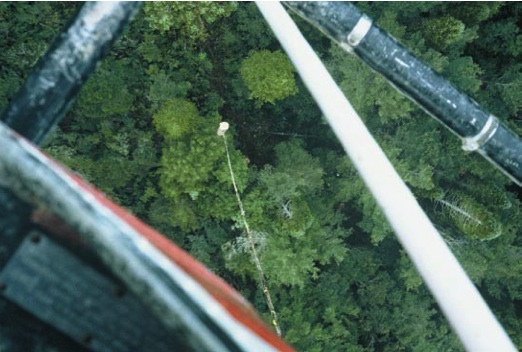
Several harvest methods are available including one, or a combination of –
- Ground based, such as tractor or rubber tyred skidder
- Cable system
- Aerial extraction by helicopter.
Issues to consider when choosing a harvesting system include –
- Selection method of single tree, small group or coupe of specified size. Whichever is chosen, and all could be used in the same area, depends more upon the ecology of the species being grown than any other aspect.
- Steepness of site
- Environmental considerations such as the potential for soil and water damage.
Combined with the above are the requirements of the Resource Management Act, especially the requirements of regional and district plans and consideration of extraction method, roading and skid track patterns and costs.
Environmental impact
There are two issues involved, the impact on the residual vegetation and the damage to soil and water values. Damage is reduced by choosing the best method for the job and using well trained operators. Helicopter logging extraction usually causes the least damage and tracked or wheeled skidders the most.
Land use consents
Prior to construction of roads and the clearing of vegetation from an area greater than a certain size, a land use consent may be required from the local regional council. Because continuous cover forestry only requires the felling of trees on very small areas, a clearing permit may not be needed.
When granting consent, regional councils must take notice of Section 17 of the Resource Management Act which states the duty to avoid, remedy or mitigate adverse effects on the environment.
Roading
Continuous cover forests on easy country generally require a denser roading network than forests which are clear felled. Ground harvest methods involve extracting logs by hauling through the trees to the road, either by small skidder, agricultural tractor, mini skidder or horse.
Roads must be built to a standard high enough to easily extract logs while protecting the soil from erosion. Unlike clear felling, where roads may only be heavily used once every 25 or 30 years, continuous cover forestry use will be lighter but more or less continuous.
Harvest methods
On reasonably flat country with less than 15 degree average slope, ground extraction is less expensive. On steeper country helicopter extraction, although more costly, is better. Small haulers may have a role in some places.
Ground harvest methods using horse and mini skidder which have low impact on the environment also have low production potential. They are applicable in small scale operations where the value of the timber is moderately high. Hauler systems have high productivity, but the greater impact on the environment restricts their use in continuous cover forestry. Skidders, which can also have negative environmental impacts, are only applicable on flat and easy country. On balance helicopter extraction is best, not only because of minimal damage to other plants and the soil, but also because the need for road construction is greatly reduced. However timber value must be reasonably high to permit helicopters to be economic.
This outline is intended to give a brief overview of the principles and practice of continuous cover forestry. Much more information will be needed by those who wish to investigate the subject further. In part, this will be met by a manual being prepared by Tane’s Tree Trust with the assistance of a Sustainable Farming Farm grant. However the only way to understand the system is to begin practising it.
It is hoped that over the next few years many will take up the challenge. To this end Tane’s Tree Trust would like to hear from anyone who has comments on these continuous cover forestry articles, because discussion now can only make the proposed manual better.
Further reading
Benecke U 1996 – Ecological silviculture: The application of age-old methods. New
Zealand Journal of Forestry.
Benecke U 1996 Near natural sustainable forestry from an international perspective. In Native Trees for the Future. Eds. W Silvester, R McGowan. Proceedings of a Forum held at the University of Waikato.
Helliwell R 1999 Continuous cover forestry. Published by author.
Mason B, Kerr G & Simpson J 1999 What is continuous cover forestry? Information Note FCIN 29. Forestry Commission.
Matthews J D 1999 Silvicultural Systems. Clarendon Press.
Ian Barton is a registered forestry consultant

 Farm Forestry New Zealand
Farm Forestry New Zealand